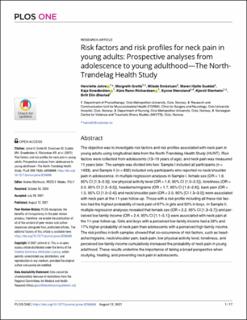Risk factors and risk profiles for neck pain in young adults: Prospective analyses from adolescence to young adulthood—The North- Trøndelag Health Study
| dc.contributor.author | Jahre, Henriette | |
| dc.contributor.author | Grotle, Margreth | |
| dc.contributor.author | Småstuen, Milada Cvancarova | |
| dc.contributor.author | Guddal, Maren Hjelle | |
| dc.contributor.author | Smedbråten, Kaja | |
| dc.contributor.author | Richardsen, Kåre Rønn | |
| dc.contributor.author | Stensland, Synne | |
| dc.contributor.author | Storheim, Kjersti | |
| dc.contributor.author | Øiestad, Britt Elin | |
| dc.date.accessioned | 2021-12-15T14:58:08Z | |
| dc.date.available | 2021-12-15T14:58:08Z | |
| dc.date.created | 2021-11-10T21:55:15Z | |
| dc.date.issued | 2021-08-12 | |
| dc.identifier.issn | 1932-6203 | |
| dc.identifier.uri | https://hdl.handle.net/11250/2834543 | |
| dc.description.abstract | The objective was to investigate risk factors and risk profiles associated with neck pain in young adults using longitudinal data from the North-Trøndelag Health Study (HUNT). Risk factors were collected from adolescents (13–19 years of age), and neck pain was measured 11 years later. The sample was divided into two: Sample I included all participants (n = 1433), and Sample II (n = 832) included only participants who reported no neck/shoulder pain in adolescence. In multiple regression analyses in Sample I, female sex (OR = 1.9, 95% CI [1.3–2.9]), low physical activity level (OR = 1.6, 95% CI [1.0–2.5]), loneliness (OR = 2.0, 95% CI [1.2–3.5]), headache/migraine (OR = 1.7, 95% CI [1.2–2.6]), back pain (OR = 1.5, 95% CI [1.0–2.4]) and neck/shoulder pain (OR = 2.0, 95% [CI 1.3–3.0]) were associated with neck pain at the 11-year follow-up. Those with a risk profile including all these risk factors had the highest probability of neck pain of 67% in girls and 50% in boys. In Sample II, multiple regression analyses revealed that female sex (OR = 2.2, 95% CI [1.3–3.7]) and perceived low family income (OR = 2.4, 95% CI [1.1–5.1]) were associated with neck pain at the 11-year follow-up. Girls and boys with a perceived low family income had a 29% and 17% higher probability of neck pain than adolescents with a perceived high family income. The risk profiles in both samples showed that co-occurrence of risk factors, such as headache/migraine, neck/shoulder pain, back pain, low physical activity level, loneliness, and perceived low family income cumulatively increased the probability of neck pain in young adulthood. These results underline the importance of taking a broad perspective when studying, treating, and preventing neck pain in adolescents. | en_US |
| dc.description.sponsorship | Oslo Metropolitan University funded this paper to HJ through a PhD position. | en_US |
| dc.language.iso | eng | en_US |
| dc.publisher | Public Library of Science | en_US |
| dc.relation.ispartofseries | PLOS ONE;16 (8): e0256006 | |
| dc.rights | Navngivelse 4.0 Internasjonal | * |
| dc.rights.uri | http://creativecommons.org/licenses/by/4.0/deed.no | * |
| dc.subject | Pains | en_US |
| dc.subject | Necks | en_US |
| dc.subject | Physical activities | en_US |
| dc.subject | Medical risk factors | en_US |
| dc.subject | Adolescents | en_US |
| dc.subject | Abdominal pains | en_US |
| dc.subject | Lower back pains | en_US |
| dc.title | Risk factors and risk profiles for neck pain in young adults: Prospective analyses from adolescence to young adulthood—The North- Trøndelag Health Study | en_US |
| dc.type | Peer reviewed | en_US |
| dc.type | Journal article | en_US |
| dc.description.version | publishedVersion | en_US |
| dc.rights.holder | © 2021 Jahre et al. | en_US |
| dc.source.articlenumber | e0256006 | en_US |
| cristin.ispublished | true | |
| cristin.fulltext | original | |
| cristin.qualitycode | 1 | |
| dc.identifier.doi | https://doi.org/10.1371/journal.pone.0256006 | |
| dc.identifier.cristin | 1953434 | |
| dc.source.journal | PLOS ONE | en_US |
| dc.source.volume | 16 | en_US |
| dc.source.issue | 8 | en_US |
| dc.source.pagenumber | 1-17 | en_US |
Tilhørende fil(er)
Denne innførselen finnes i følgende samling(er)
-
HV - Institutt for fysioterapi (GAMMEL) [336]
HV - Department of Physiotherapy (OLD) -
HV - Institutt for sykepleie og helsefremmende arbeid [1386]
HV - Department of Nursing and Health Promotion -
Publikasjoner fra Cristin [3196]

